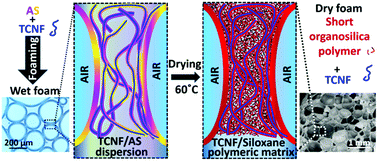当前位置:
X-MOL 学术
›
Mater. Chem. Front.
›
论文详情
Our official English website, www.x-mol.net, welcomes your
feedback! (Note: you will need to create a separate account there.)
Lightweight foams of amine-rich organosilica and cellulose nanofibrils by foaming and controlled condensation of aminosilane†
Materials Chemistry Frontiers ( IF 6.0 ) Pub Date : 2018-09-19 00:00:00 , DOI: 10.1039/c8qm00360b Korneliya Gordeyeva 1, 2, 3, 4 , Hugo Voisin 1, 2, 3, 4 , Niklas Hedin 1, 2, 3, 4 , Lennart Bergström 1, 2, 3, 4 , Nathalie Lavoine 1, 2, 3, 4, 5
Materials Chemistry Frontiers ( IF 6.0 ) Pub Date : 2018-09-19 00:00:00 , DOI: 10.1039/c8qm00360b Korneliya Gordeyeva 1, 2, 3, 4 , Hugo Voisin 1, 2, 3, 4 , Niklas Hedin 1, 2, 3, 4 , Lennart Bergström 1, 2, 3, 4 , Nathalie Lavoine 1, 2, 3, 4, 5
Affiliation

|
Organosilica foams are commonly formed by a multistep process involving hydrolysis and condensation of organosilanes followed by solvent exchange and e.g. supercritical CO2 drying. Here, we propose a straightforward route to synthesize lightweight hybrid foams from aqueous dispersions of a surface-active aminosilane (AS) and TEMPO-oxidized cellulose nanofibrils (TCNFs). Air bubbles were introduced in the TCNF/AS dispersion by mechanical blending, and the foam was solidified by oven-drying. Evaporative drying at mild temperature (60 °C) resulted in dry foams with low densities (25–50 kg m−3), high porosities (96–99%) and macropores of 150–300 μm in diameter. The foaming and foam stabilization were successful for a pH range of 10.4–10.8 for foams containing 55–65 wt% of organosilica in the dry state. The protonation of AS increased the ionic strength of the dispersion and enhanced the interparticle interactions with TCNFs and, in turn, the foam viscosity and foam stability upon drying. The evaporation of water catalyzed the condensation of the AS to form low-molecular linear polymers, which resulted in an increased stiffness and strength of the foam lamella. The crosslinking of the AS polymeric network with the TCNF matrix allowed lightweight and homogeneous macroporous foams to be obtained with controlled densities and high amine content (amine content >4.5 mmol g−1) using an environmentally friendly technique.
中文翻译:

通过氨基硅烷的发泡和受控缩合,制成富含胺的有机二氧化硅和纤维素纳米原纤维的轻质泡沫†
有机硅泡沫通常通过包括有机硅烷的水解和缩合然后进行溶剂交换和例如超临界CO 2干燥的多步骤过程形成。在这里,我们提出了一种从表面活性氨基硅烷(AS)和TEMPO氧化纤维素纳米纤丝(TCNFs)的水分散体合成轻质杂化泡沫的简单途径。通过机械混合将气泡引入TCNF / AS分散体中,并通过烘箱干燥使泡沫固化。在温和的温度下(60°C)进行蒸发干燥,得到的干泡沫密度低(25–50 kg m -3),高孔隙率(96–99%)和大孔,直径为150–300μm。在干燥状态下,含有55-65 wt%的有机硅的泡沫的pH范围为10.4-10.8时,泡沫和泡沫稳定作用是成功的。AS的质子化提高了分散体的离子强度,并增强了与TCNFs的颗粒间相互作用,继而提高了干燥后的泡沫粘度和泡沫稳定性。水的蒸发催化了AS的缩合以形成低分子线性聚合物,这导致泡沫薄片的刚度和强度增加。AS聚合物网络与TCNF基质的交联使得可以得到密度控制且胺含量高(胺含量> 4.5 mmol g -1的轻质均质大孔泡沫))使用环保技术。
更新日期:2018-09-19
中文翻译:

通过氨基硅烷的发泡和受控缩合,制成富含胺的有机二氧化硅和纤维素纳米原纤维的轻质泡沫†
有机硅泡沫通常通过包括有机硅烷的水解和缩合然后进行溶剂交换和例如超临界CO 2干燥的多步骤过程形成。在这里,我们提出了一种从表面活性氨基硅烷(AS)和TEMPO氧化纤维素纳米纤丝(TCNFs)的水分散体合成轻质杂化泡沫的简单途径。通过机械混合将气泡引入TCNF / AS分散体中,并通过烘箱干燥使泡沫固化。在温和的温度下(60°C)进行蒸发干燥,得到的干泡沫密度低(25–50 kg m -3),高孔隙率(96–99%)和大孔,直径为150–300μm。在干燥状态下,含有55-65 wt%的有机硅的泡沫的pH范围为10.4-10.8时,泡沫和泡沫稳定作用是成功的。AS的质子化提高了分散体的离子强度,并增强了与TCNFs的颗粒间相互作用,继而提高了干燥后的泡沫粘度和泡沫稳定性。水的蒸发催化了AS的缩合以形成低分子线性聚合物,这导致泡沫薄片的刚度和强度增加。AS聚合物网络与TCNF基质的交联使得可以得到密度控制且胺含量高(胺含量> 4.5 mmol g -1的轻质均质大孔泡沫))使用环保技术。











































 京公网安备 11010802027423号
京公网安备 11010802027423号